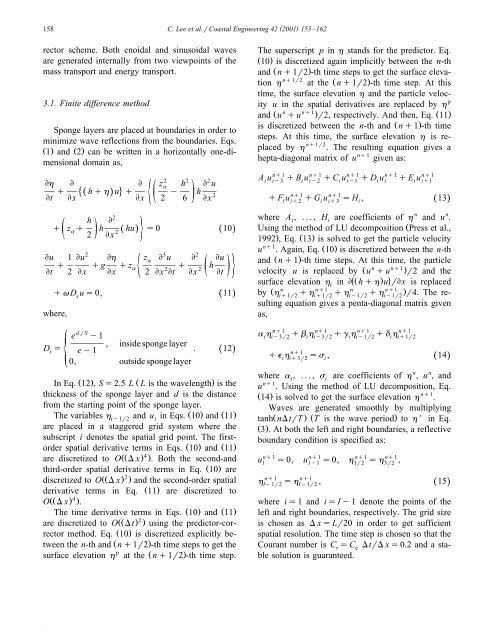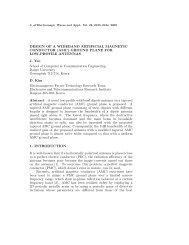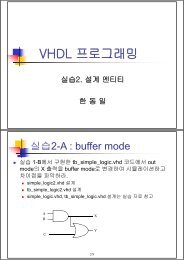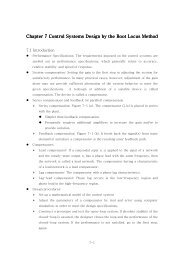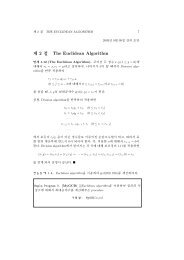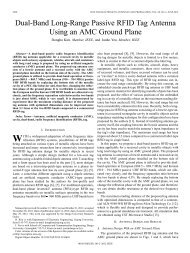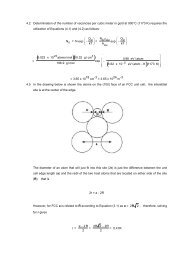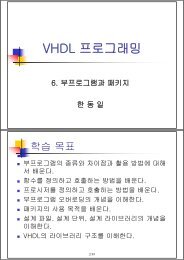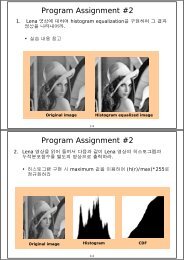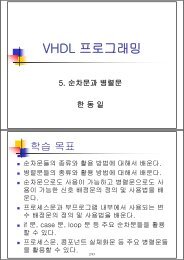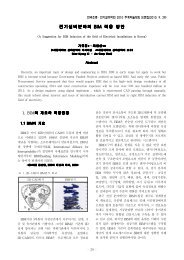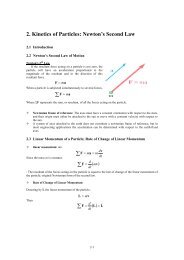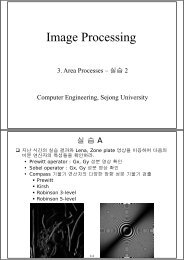Internal generation of waves for extended Boussinesq equations
Internal generation of waves for extended Boussinesq equations
Internal generation of waves for extended Boussinesq equations
You also want an ePaper? Increase the reach of your titles
YUMPU automatically turns print PDFs into web optimized ePapers that Google loves.
158<br />
( )<br />
C. Lee et al.rCoastal Engineering 42 2001 155–162<br />
rector scheme. Both cnoidal and sinusoidal <strong>waves</strong><br />
are generated internally from two viewpoints <strong>of</strong> the<br />
mass transport and energy transport.<br />
3.1. Finite difference method<br />
Sponge layers are placed at boundaries in order to<br />
minimize wave reflections from the boundaries. Eqs.<br />
Ž. 1 and Ž. 2 can be written in a horizontally one-dimensional<br />
domain as,<br />
½ž /<br />
Eh E E z 2 a h 2 E 2 u<br />
q Ž hqh. u4<br />
q y h<br />
2<br />
Et Ex Ex 2 6 Ex<br />
ž /<br />
h E 2<br />
q z q h Ž hu. s0 Ž 10.<br />
2 Ex<br />
a 2 5<br />
½ ž / 5<br />
Eu 1 Eu 2 Eh za<br />
E 3 u E 2 Eu<br />
q qg qza q h<br />
2 2<br />
Et 2 Ex Ex 2 Ex Et Ex Et<br />
qv Dus0, s<br />
Ž 11.<br />
where,<br />
° d r S<br />
~ e y1 , inside sponge layer<br />
Ds s ey1<br />
. Ž 12.<br />
¢ 0, outside sponge layer<br />
In Eq. Ž 12 ., Ss2.5 L Ž L is the wavelength.<br />
is the<br />
thickness <strong>of</strong> the sponge layer and d is the distance<br />
from the starting point <strong>of</strong> the sponge layer.<br />
The variables h and u in Eqs. Ž 10. and Ž 11.<br />
iy1r2 i<br />
are placed in a staggered grid system where the<br />
subscript i denotes the spatial grid point. The firstorder<br />
spatial derivative terms in Eqs. Ž 10. and Ž 11.<br />
are discretized to OŽŽ D x . 4 .. Both the second-and<br />
third-order spatial derivative terms in Eq. Ž 10.<br />
are<br />
discretized to OŽŽ D x. 2 . and the second-order spatial<br />
derivative terms in Eq. Ž 11.<br />
are discretized to<br />
OŽŽ D x . 4 ..<br />
The time derivative terms in Eqs. Ž 10. and Ž 11.<br />
are discretized to OŽŽ Dt. 2 . using the predictor-corrector<br />
method. Eq. Ž 10.<br />
is discretized explicitly between<br />
the n-th and Ž nq1r2.<br />
-th time steps to get the<br />
p<br />
surface elevation h at the Ž nq1r2.<br />
-th time step.<br />
The superscript p in h stands <strong>for</strong> the predictor. Eq.<br />
Ž 10.<br />
is discretized again implicitly between the n-th<br />
and Ž nq1r2.<br />
-th time steps to get the surface elevanq1r2<br />
tion h at the Ž nq1r2.<br />
-th time step. At this<br />
time, the surface elevation h and the particle velocity<br />
u in the spatial derivatives are replaced by h p<br />
and Žu n qu nq1 . r2, respectively. And then, Eq. Ž 11.<br />
is discretized between the n-th and Ž nq1.<br />
-th time<br />
steps. At this time, the surface elevation h is replaced<br />
by h nq1r2 . The resulting equation gives a<br />
hepta-diagonal matrix <strong>of</strong> u nq1 given as:<br />
Au nq1 qBu nq1 qCu nq1 qDu nq1 qEu nq1<br />
i iy3 i iy2 i iy1 i i i iq1<br />
qFiuiq2 nq1 qGu i iq3 nq1 sH i , Ž 13.<br />
where A i, ..., Hi<br />
are coefficients <strong>of</strong> h n and u n .<br />
Using the method <strong>of</strong> LU decomposition ŽPress et al.,<br />
1992 ., Eq. Ž 13.<br />
is solved to get the particle velocity<br />
nq1<br />
u . Again, Eq. Ž 10.<br />
is discretized between the n-th<br />
and Ž nq1.<br />
-th time steps. At this time, the particle<br />
velocity u is replaced by Žu n qu nq1 . r2 and the<br />
surface elevation h in EŽ hqh. u4<br />
i<br />
rEx is replaced<br />
Ž<br />
n nq1 n nq1<br />
by h qh qh qh .<br />
iq1r2 iq1r2 iy1r2 iy1r2 r4. The re-<br />
sulting equation gives a penta-diagonal matrix given<br />
as,<br />
ah nq1 qbh nq1 qgh nq1 qdh nq1<br />
i iy5r2 i iy3r2 i iy1r2 i iq1r2<br />
qeihiq3r2 nq1 ss i , Ž 14.<br />
where a i, ..., si<br />
are coefficients <strong>of</strong> h n , u n , and<br />
u nq1 . Using the method <strong>of</strong> LU decomposition, Eq.<br />
Ž .<br />
nq1<br />
14 is solved to get the surface elevation h .<br />
Waves are generated smoothly by multiplying<br />
Ž . Ž .<br />
)<br />
tanh nDtrT T is the wave period to h in Eq.<br />
Ž. 3 . At both the left and right boundaries, a reflective<br />
boundary condition is specified as:<br />
u nq1 s0, u nq1 s0, h nq1 sh nq1 ,<br />
1 Iy1 1r2 3r2<br />
h nq1 sh nq1 , Ž 15.<br />
Iy1r2<br />
Iy3r2<br />
where is1 and isIy1 denote the points <strong>of</strong> the<br />
left and right boundaries, respectively. The grid size<br />
is chosen as D xsLr20 in order to get sufficient<br />
spatial resolution. The time step is chosen so that the<br />
Courant number is CrsCe<br />
DtrD xs0.2 and a sta-<br />
ble solution is guaranteed.


